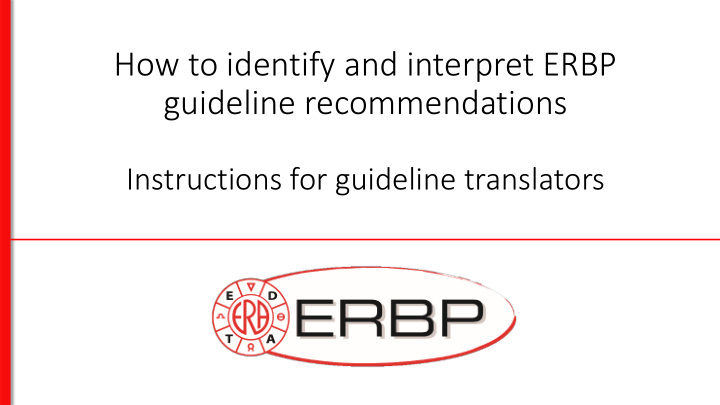



How to identify and interpret ERBP guideline recommendations Instructions for guideline translators
Recommendations form the core of any clinical practice guideline, and therefore require special attention during the process of translation. For recommendations that are ‘graded’, ERBP uses a standardised terminology. This terminology is linked to a specific meaning, and should therefore be maintained and used consistently in the translated guideline. This presentation helps you identify recommendations within the guideline document, recognise ‘graded’ recommendations, and interpret their intention and meaning.
Identifying recommendations in the guideline Recommendations are summarised at the beginning of a section; presented in a box; preceded by a number, which includes the section number; followed by a ‘grade’ (for example, 1B, 2C, not graded).
Identifying recommendations in the guideline Beginning of a section Presented in a box Followed by a grade Preceded by a number Followed by a grade
Grading of recommendations Recommendations can be graded or not graded. The ‘grade’ is stated in parenthesis at the end of each recommendation. Example of a graded recommendation • A grade consists of a number (1 or 2) and a letter (A to D) • Graded statements use a standardised terminology Example of an ungraded recommendation • Recognisable by the text ‘not graded’ • Ungraded statements do not use a standardised terminology
Ungraded recommendations Grade ‘not graded’ Terminology No standardised terminology, but they cannot contain words (that are similar to words) like ‘recommend’, ‘suggest’, ‘should’, ‘must’, ‘have to’, etc. Meaning Simple declarative statements that are not meant to be interpreted as being stronger recommendations than those graded ‘1’ or ‘2’ (see next slide). They typically refer to monitoring intervals, counselling, and referral to other specialists. Example:
Graded recommendations Graded recommendations are either strong (graded ‘1’) or weak (graded ‘2’). Strong and weak recommendations have different implications for the stakeholders (see table below; adapted from Guyatt et al. BMJ 2008). [Note: The letters A to D, which form the second part of a grade, reflect the quality of the underlying evidence. They do not affect recommendations’ terminology, and can therefore be disregarded in the context of guideline translation]
Graded recommendations There is a standardised terminology for all graded recommendations. This terminology should be maintained and used consistently in the translated guideline. The terminology depends on if the recommendation is strong or weak ; is for or against a certain treatment strategy; refrains from recommending a certain treatment strategy or not.
Stro rong recommendations for a certain strategy Grade ‘1’, followed by any letter Terminology We recommend... Meaning Most physicians and patients would definitely do it if they knew all evidence Example:
Stro rong recommendations against a certain strategy Grade ‘1’, followed by any letter Terminology We recommend against... Meaning Most physicians and patients would d efinitely don’t do it if they knew the evidence Example:
Stro rong recommendations that explicitly re refrain fr from recommending (a (against) a certain strategy Grade ‘1’, followed by any letter Terminology We do not recommend... Meaning No specific recommendation can be made, as the supporting evidence is conflicting or uncertain. Example:
Weak recommendations for a certain strategy Grade ‘2’, followed by any letter Terminology We suggest ... Meaning Many physicians and patients would probably do it if they knew the evidence, but many would probably not. Example:
Weak recommendations against a certain strategy Grade ‘2’, followed by any letter Terminology We suggest against ... Meaning Many physicians and patients would p robably don’t do it if they knew the evidence, but many probably would. Example:
Weak recommendations that explicitly re refrain fr from sugg ggesting (a (against) a certain strategy Grade ‘2’, followed by any letter Terminology We do not suggest ... Meaning No specific suggestions can be made, as the supporting evidence is conflicting or uncertain. [No example available in the hyponatraemia guideline]
Recommend
More recommend